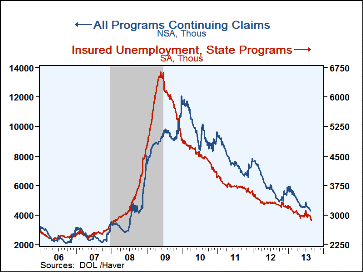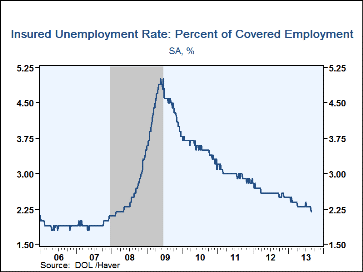 Global| Sep 12 2013
Global| Sep 12 2013U.S. Initial Claims for Unemployment Insurance Drop to 7-1/2-Year Low; Processing Issues May Have Impacted Report
Summary
Initial claims for unemployment insurance in the September 7 week dropped to 292,000 from 323,000 the week before, which was unrevised. The September 7 figure is the first below 300,000 since May 12, 2007, which was 297,000, and is [...]
 Initial claims for unemployment insurance in the September 7 week dropped to 292,000 from 323,000 the week before, which was unrevised. The September 7 figure is the first below 300,000 since May 12, 2007, which was 297,000, and is the lowest since 283,000 the week of February 18, 2006. The Action Economics Forecast Survey looked for a small rise to 329,000. The four-week moving average of initial claims fell to 321,250, its lowest since October 13, 2007. Separate discussion from the Labor Department indicates that these otherwise impressive looking advance figures may well be revised since two states, not yet publicly identified, are known to have experienced processing difficulties last week.
Initial claims for unemployment insurance in the September 7 week dropped to 292,000 from 323,000 the week before, which was unrevised. The September 7 figure is the first below 300,000 since May 12, 2007, which was 297,000, and is the lowest since 283,000 the week of February 18, 2006. The Action Economics Forecast Survey looked for a small rise to 329,000. The four-week moving average of initial claims fell to 321,250, its lowest since October 13, 2007. Separate discussion from the Labor Department indicates that these otherwise impressive looking advance figures may well be revised since two states, not yet publicly identified, are known to have experienced processing difficulties last week.
Continuing claims for unemployment insurance in the week ended August 31 declined to 2.871 million (-12.8% y/y) from 2.944 million in the August 24 week. The four-week moving average of continuing claims fell to 2.953 million. The insured rate of unemployment decreased to 2.2%, the low since May 10, 2008. This particular count covers only "regular" programs and does not include all extended benefit and other specialized jobless insurance programs. In the week of August 24, the latest figure available, the total of all benefit recipients declined to 4.273 million (-20.7% y/y). This broader measure is not seasonally adjusted. It compares to a cycle peak of 12.060 million in January 2010 and pre-recession figures that averaged 2.596 million for 2007. The number of individuals who were collecting emergency and extended payments in the week of August 24 slipped to 1.455 million (-34.6% y/y) from 1.495 million the week before.
By state, the insured rate of unemployment ranged from lows of 0.40% in South Dakota, 0.52% in North Dakota to the high end with 3.12% in Pennsylvania, 3.27% in Arkansas, 3.38% in Connecticut, 3.56% in New Jersey and 4.28% in Puerto Rico.
Data on weekly unemployment insurance are contained in Haver's WEEKLY database and they are summarized monthly in USECON. Data for individual states are in REGIONW. The consensus estimates come from the Action Economics survey, carried in the AS1REPNA database.
| Unemployment Insurance (000s) | 09/07/13 | 08/31/13 | 08/24/13 | Y/Y % | 2012 | 2011 | 2010 |
|---|---|---|---|---|---|---|---|
| Initial Claims | 292 | 323 | 333 | -23.8 | 375 | 409 | 459 |
| Continuing Claims | -- | 2,871 | 2,944 | -12.4 | 3,318 | 3,744 | 4,544 |
| Insured Unemployment Rate (%) | -- | 2.2 | 2.3 | 2.6 (9/12) |
2.6 | 3.0 | 3.6 |
| Total "All Programs" (NSA) | -- | -- | 4.273 mil. | -20.7 | 6.047 mil. | 7.750 mil. | 9.850 mil. |
Carol Stone, CBE
AuthorMore in Author Profile »Carol Stone, CBE came to Haver Analytics in 2003 following more than 35 years as a financial market economist at major Wall Street financial institutions, most especially Merrill Lynch and Nomura Securities. She has broad experience in analysis and forecasting of flow-of-funds accounts, the federal budget and Federal Reserve operations. At Nomura Securites, among other duties, she developed various indicator forecasting tools and edited a daily global publication produced in London and New York for readers in Tokyo. At Haver Analytics, Carol is a member of the Research Department, aiding database managers with research and documentation efforts, as well as posting commentary on select economic reports. In addition, she conducts Ways-of-the-World, a blog on economic issues for an Episcopal-Church-affiliated website, The Geranium Farm. During her career, Carol served as an officer of the Money Marketeers and the Downtown Economists Club. She has a PhD from NYU's Stern School of Business. She lives in Brooklyn, New York, and has a weekend home on Long Island.







